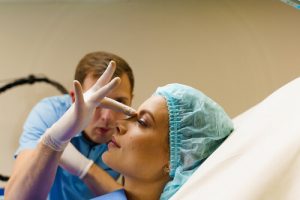Navigating the world of medical procedures can be a maze, especially when it comes to specialised surgeries. Among these, septoplasty and turbinoplasty often emerge, especially in discussions about nasal relief and respiratory improvements. But what exactly are these procedures, and how do they complement each other?
In this article, we’ll delve deep into the intricacies of septoplasty and turbinoplasty, shedding light on their significance and the transformative impact they can have on one’s quality of life. If you’ve ever wondered about the wonders of modern medical advancements in ENT, you’re in for an enlightening read. Stay with us as we unravel the mystery.
What are septoplasty and turbinate reduction
 In the intricate realm of otolaryngology, certain procedures stand out for their profound impact on enhancing respiratory function and overall quality of life.
In the intricate realm of otolaryngology, certain procedures stand out for their profound impact on enhancing respiratory function and overall quality of life.
Among these, septoplasty and turbinate reduction are frequently discussed yet often misunderstood. Let’s delve deeper into these surgical interventions to understand their significance. Septoplasty and turbinate reduction are two distinct but often complementary procedures aimed at improving nasal airflow and alleviating breathing difficulties.
Septoplasty:
This surgical procedure is designed to straighten a deviated nasal septum. The nasal septum, a thin wall made of cartilage and bone, divides the nasal cavity into two. When this septum deviates or shifts to one side, it can obstruct airflow, leading to breathing difficulties, snoring, and recurrent sinus infections. Septoplasty corrects this deviation by realigning the septum to its central position, ensuring optimal airflow and alleviating associated symptoms.
Turbinate Reduction Surgery:
Conversely, the turbinates are small, bony structures lined with soft tissue on the sides of the nasal passages. Their primary role is to warm, humidify, and filter our air. However, these turbinates can become enlarged due to allergies, environmental irritants, or other factors, leading to nasal obstruction. Turbinate reduction , often called “turbinoplasty,” aims to reduce the size of these enlarged turbinates, enhancing airflow and improving breathing.
In many cases, patients with a deviated septum also have enlarged turbinates. Hence, doctors might recommend a combined approach, performing both septoplasty and turbinate reduction simultaneously. This dual procedure ensures comprehensive relief from nasal obstructions and optimises respiratory function.
What are the differences between septoplasty and turbinate reduction?
The intricacies of nasal surgeries often revolve around two prominent procedures: septoplasty and turbinate reduction. Both are designed to enhance normal nasal function and alleviate breathing difficulties. However, they cater to different anatomical issues within the nasal passages. Let’s break down the distinctions between these two surgeries.
Targeted Anatomy:
- Septoplasty: Focuses on the septum, the thin wall made of cartilage and bone that divides the nasal passages.
- Turbinate Reduction: Addresses the nasal turbinates, small bony structures inside the nose lined with soft tissue.
Primary Purpose:
- Septoplasty: Aims to rectify a deviated septum, which can lead to a blocked nose and complications like sinus infections.
- Turbinate Reduction: Seeks to reduce the size of enlarged turbinates that obstruct airflow.
Procedure Details:
- Septoplasty: Involves reshaping or removing parts of the deviated septal cartilage and bone. Post-, nasal splints might be placed inside the nostrils for support.
- Turbinate Reduction: Uses a special instrument to decrease the size of the turbinates, enhancing airflow. The focus is on the side wall of the nasal passages.
Post-Operative Care:
- Septoplasty: Patients might experience swelling and bleeding. They’re often advised to keep their head elevated and avoid vigorous activities.
- Turbinate Reduction: Emphasises minimising bleeding post-, often with medications like tranexamic acid. Pain medication and antibiotics might also be prescribed.
Outcome:
- Septoplasty: Restores clear nasal breathing by straightening the deviated septum.
- Turbinate Reduction: Improves airflow by addressing the obstructions caused by enlarged turbinates.
Combined Procedures:
It’s worth noting that some patients might undergo both septoplasty and turbinate reduction simultaneously, depending on the doctor’s assessment and the patient’s specific needs.
In summary, while septoplasty and turbinate reduction are geared towards improving nasal breathing, they address distinct anatomical challenges within the nose. Understanding these differences is crucial for anyone considering nasal .
The uses of septoplasty and turbinate reduction
Septoplasty and turbinate reduction are pivotal procedures in otolaryngology, specifically targeting the nasal passages. While both surgeries aim to enhance the nose’s functionality and alleviate breathing difficulties, they serve distinct purposes and cater to different anatomical challenges. Let’s delve into the primary uses of these two surgical interventions.
Addressing Deviated Septum:
- Septoplasty: This procedure is primarily employed to correct a deviated septum. The septum, a thin wall made of cartilage and bone, divides the nasal passages. When it’s misaligned or deviated, it can obstruct one or both nostrils, leading to breathing difficulties, recurrent sinus infections, and nasal congestion.
Alleviating Enlarged Turbinates:
- Turbinate Reduction: The nasal turbinates are small, bony structures inside the nose that help filter, warm, and humidify the air we breathe. Over time, these turbinates can become enlarged for various reasons, including allergies or chronic inflammation. Turbinate reduction aims to reduce the size of these enlarged turbinates to improve airflow and alleviate symptoms like nasal blockage.
Enhancing Overall Nasal Breathing:
- Both septoplasty and turbinate reduction surgeries serve the overarching goal of improving nasal breathing. By addressing the anatomical challenges within the nasal passages, these procedures ensure a clearer airway, leading to better oxygen intake and overall respiratory health.
Relief from Chronic Symptoms:
- Persistent symptoms like nasal congestion, difficulty breathing, recurrent sinus infections, and even sleep disturbances can be alleviated through these surgeries. By rectifying the underlying anatomical issues, patients often experience significant relief and an enhanced quality of life.
In conclusion, septoplasty and turbinate reduction , while distinct in their primary focus, collectively serve the purpose of enhancing nasal function. Whether individually or in tandem, these procedures are crucial in addressing common nasal obstructions and improving respiratory health.
Drawbacks of septoplasty and turbinate reduction

Septoplasty and turbinate reduction , while offering significant relief to patients with nasal obstructions, are not without their potential drawbacks. As with any surgical intervention, there are inherent risks and possible complications. Understanding these drawbacks is essential for anyone considering these procedures, ensuring they are well informed and prepared for the post-operative journey.
- Surgical Risks: As with any , septoplasty and turbinate reduction come with general surgical risks such as bleeding, infection, and adverse reactions to anaesthesia.
- Incomplete Resolution: The may not fully alleviate the breathing difficulties. Some patients may still experience nasal obstructions or other symptoms post-.
- Scarring: Internal scarring can occur after the , potentially leading to nasal obstruction. In rare cases, this scarring might necessitate further surgical intervention.
- Altered Sense of Smell: Some patients report a temporary or permanent change in their sense of smell following the .
- Nasal Dryness or Crusting: Post-, patients might experience increased dryness inside the nose, leading to discomfort and the formation of crusts.
- Numbness: Temporary numbness or tingling around the nose or upper front teeth can occur after the procedure.
- Cosmetic Concerns: While septoplasty and turbinate reduction are functional surgeries, there’s a slight risk of external nasal shape changes, which might not be aesthetically pleasing to some patients.
- Post-operative Pain: Pain, swelling, and bruising are common post-operative symptoms. While these are usually temporary, they can cause significant discomfort.
- Potential for Revision Surgery: In some cases, the initial might not yield the desired results, or complications might arise, necessitating a revision .
In conclusion, while septoplasty and turbinate reduction offer substantial benefits to those with nasal obstructions, it’s crucial to weigh these against the potential drawbacks. A thorough consultation with a specialist can provide a clearer picture, ensuring patients make informed decisions about their health.
Recovery from turbinoplasty and septoplasty
Recovery from turbinoplasty and septoplasty is a crucial phase that determines the success of the surgical intervention. While these procedures are commonly performed to address nasal obstructions, the post-operative period requires careful attention and adherence to medical advice to ensure optimal healing and outcomes. Here’s a detailed look at what patients can expect during the recovery phase.
- Immediate Post-operative Phase: After the , patients are typically observed for a few hours before being discharged. Some might experience grogginess due to the anaesthesia, which usually subsides within a day.
- Pain and Discomfort: Mild to moderate pain is expected after the . Pain medication, as prescribed by the doctor, can help manage this discomfort.
- Nasal Congestion and Discharge: It’s common to experience nasal congestion and a bloody discharge in the initial days following the procedure. Using saline sprays can help keep the nasal passages moist and facilitate healing.
- Avoiding Strenuous Activities: Patients should refrain from vigorous physical activities for at least two weeks post- to prevent complications or increased swelling.
- Follow-up Visits: Regular check-ups with the doctor are essential to monitor the healing process, remove any internal splints or stitches, and address any concerns.
- Swelling and Bruising: Some patients might notice swelling or bruising around the nose or eyes. Keeping the head elevated, even during sleep, can help reduce this swelling.
- Breathing Improvements: While immediate relief in breathing is noticed by many, the full benefits are typically realised a few weeks post- as the internal swelling subsides.
- Avoiding Nasal Trauma: It’s crucial to be gentle with the nose during the recovery phase. Avoid blowing the nose vigorously, picking, or any potential trauma to the area.
- Long-term Recovery: While most symptoms and discomforts subside within a few weeks, complete healing, especially internal, can take several months. Adhering to medical advice and being patient during this period is essential for the best outcomes.
In conclusion, while turbinoplasty and septoplasty are effective procedures to address nasal obstructions, the recovery phase plays a pivotal role in most patients have in determining overall success. By understanding the recovery process and following post-operative care instructions diligently, patients can look forward to improved nasal function and overall well-being.
Conclusion
In wrapping up, the journey of understanding septoplasty and turbinoplasty sheds light on the transformative impact these procedures can have to improve breathing and one’s quality of life. As with any medical intervention, being well-informed is key. With the right care and knowledge, those considering septoplasty and turbinoplasty can navigate their path to better nasal health and improved breathing. Remember, it’s not just about the procedure but the renewed well-being it brings.
If you’re considering septoplasty and turbinoplasty and want expert guidance on the process and costs, don’t hesitate. Reach out to the specialists at Rhinoplasty Sydney Cost today. Dial (02) 8880 5116 now and take the first step towards breathing easier and enhancing your quality of life.
References
Nasal Obstruction and Quality of Life Assessment After Septoplasty With Turbinoplasty: Correlation Between Subjective Scales
https://pubmed.ncbi.nlm.nih.gov/33297717/
Septoplasty: What It Is, Procedure & Recovery
https://my.clevelandclinic.org/health/treatments/17779-septoplasty
Changes in Nasal Airflow Parameters After Septoplasty and Turbinoplasty
https://clinicaltrials.gov/ct2/show/NCT04220853
Beyond Septoplasty and Turbinate Reduction: Correction of Nasal Valve Stenosis Adds Synergy to the Mix
https://med.uth.edu/orl/2017/04/19/beyond-septoplasty-and-turbinate-reduction-correction-of-nasal-valve-stenosis-adds-synergy-to-the-mix/
Turbinate Reduction | Stanford Health Care
https://stanfordhealthcare.org/medical-treatments/n/nasal-/types/turbinate-reduction.html

